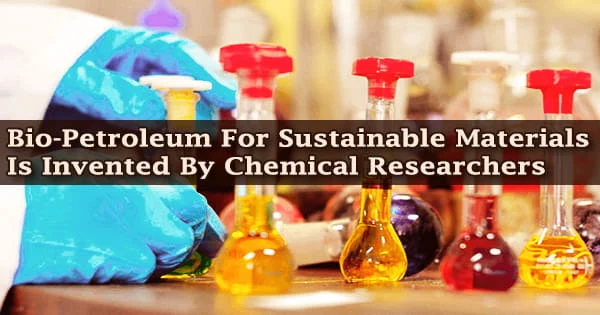A team of researchers from the University of Minnesota Twin Cities’ National Science Foundation Center for Sustainable Polymers has created a chemical method that combines fermentation and chemical refining to produce petroleum-like liquids from renewable plants.
These renewable liquids could be a more sustainable alternative to the fossil fuels that are now utilized to manufacture daily items such as plastic containers and bags, vehicle parts, lubricants, and soaps.
The new work was published online in Nature Chemistry, a premier peer-reviewed chemistry journal published by Nature Publishing Group, by scientists from the University of California Berkeley and the University of Minnesota.
Plants have been challenging to exploit as a source for plastics because they are largely made up of sugars, which are not the same as the compounds found in petroleum. Glucose is the most essential sugar in plants, however, it contains too much oxygen and has only six carbon atoms, which is insufficient for many significant applications.
Both issues must be resolved in order to use plants to create new materials. The glucose must be stripped of oxygen atoms throughout the conversion process, and molecules must be joined to create larger products.
By integrating two generally independent methods, researchers at the NSF Center for Sustainable Polymers developed an ideal technology for making sustainable liquids similar to those produced from petroleum.
To begin, plant-derived glucose was fermented with bacteria to eliminate the majority of the oxygen. Metal oxide catalysts stripped the remaining oxygen and joined molecules in the second phase, resulting in a useful distribution of olefins, which are the chemical industry’s building blocks.
These molecules contained just enough oxygen that we could readily convert them to larger more useful molecules using metal nanoparticle catalysts. This allowed us to tune the distribution of molecular products as needed, just like conventional petroleum products except for this time we were using renewable resources.
Dauenhauer
“Our insight early on was that we needed to find a molecule that could be readily made with fermentation that could strip most oxygen from glucose,” said Michelle Chang, a Professor of Chemistry and Chemical and Biomolecular Engineering at the University of California Berkeley and leader of the project.
“We optimized the chemistry to take advantage of the unique capabilities of molecular biology, after which we could solve the rest of the problem with metal nanoparticle catalysts.”
Professor Chang’s team created an Escherichia coli strain that converted glucose to eight and ten-carbon hydroxy-acids, which are molecules with only a few oxygen atoms at the end of the chain. Genetic engineering was used to improve the microorganisms’ ability to ‘produce’ these compounds from sugar.
The target molecule was created with oxygen left in crucial spots, according to Chang, to make the downstream conversion more efficient for a group of researchers led by Paul Dauenhauer, a professor of Chemical Engineering and Materials Science at the University of Minnesota.
“The biorenewable molecules that Professor Chang’s group made were perfect raw materials for catalytic refining,” said Dauenhauer, who was one of the co-authors of the research study. “These molecules contained just enough oxygen that we could readily convert them to larger more useful molecules using metal nanoparticle catalysts. This allowed us to tune the distribution of molecular products as needed, just like conventional petroleum products except for this time we were using renewable resources.”
The University of Minnesota’s Dauenhauer lab-tested a wide range of catalysts to show that bio-petroleum molecules produced by fermentation might be transformed to a variety of useful compounds.
Small molecules for essential polymers like polyethylene and polypropylene, which are utilized in items like plastic bags, and mid-size molecules for rubbery materials were among the results.
The capacity to mix fermentation product molecules to create larger molecules that can be used to make soap-like molecules for cleaning applications and longer chain molecules for lubricants was even more crucial.
The combined fermentation-catalysis technology can be tuned to manufacture almost the entire slate of unprocessed chemical materials that can be used in manufacturing processes similar to conventional petroleum but with biorenewable resources due to the breadth of possible products depending on the selected catalyst and reaction conditions.
The hybrid strategy of combined fermentation and chemical refinement has the advantage of being more cost-effective than traditional fossil-fuel-derived goods while also improving sustainability. Technologies were combined to identify the most energy-efficient and cost-effective processing procedures, resulting in the best overall efficient method of chemical production.
“This is a unique scientific approach to a new sustainable technology that was facilitated by the synergistic research that happens between disparate research groups supported in the NSF Center for Sustainable Polymers,” said Marc Hillmyer, center director and a University of Minnesota chemistry professor. “The teamwork and combined focus on solving the problem produced a new approach that would not have been possible in either of the individual research groups.”
“This advance from the NSF Center for Sustainable Polymers demonstrates a truly innovative, green entry into the building blocks for valuable polymers/plastics,” said NSF Chemistry Division Director David Berkowitz.
The Chang team has created a new, potentially bio-renewable alternative to petroleum cracking by skillfully mixing biology and chemistry. These findings indicate how NSF funding in collaborative, multidisciplinary science can help push the boundaries of chemical industry sustainability.





